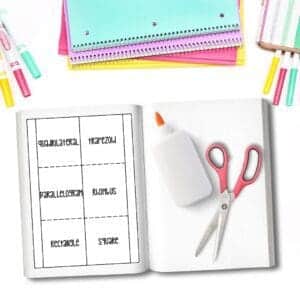Hey there 3rd and 4th grade teachers! Are you looking for a new way to teach quadrilateral shapes? Well, look no further! This blog post will provide you with simple activities that can make teaching the basics of shapes more fun and engaging for your students. Give them an experience they won’t forget as you take them on a journey around the world of quadrilaterals – from introducing their different features to playing a game to practice identification. Keep reading to get inspired and unleash your creative teacher within!
Standards covering quadrilateral shapes
- CCSS 3.G.1. Understand that shapes in different categories (e.g., rhombuses, rectangles, and others) may share attributes (e.g., having four sides) and that the shared attributes can define a larger category (e.g., quadrilaterals). Recognize rhombuses, rectangles, and squares as examples of quadrilaterals, and draw examples of quadrilaterals that do not belong to any of these subcategories.
- CCSS 4.G.2. Classify two-dimensional figures based on the presence or absence of parallel or perpendicular lines or the presence or absence of angles of a specified size. Recognize right triangles as a category, and identify right triangles.
- TEKS 3.6(B) use attributes to recognize rhombuses, parallelograms, trapezoids, rectangles, and squares of these subcategories.
- TEKS 4.6(D) classify two-dimensional figures based on the presence or absence of parallel or perpendicular lines or the presence or absence of angles of a specified size.
Introduce quadrilateral shapes with a whole group mini-lesson
One of the trickiest parts of teaching quadrilaterals is that one shape can be classified by several names. All squares are rectangles, but not all rectangles are squares! And then we throw rhombuses and parallelograms into the mix! Helping students sort through the definitions is no small task. You can start by posting the definitions of each type of quadrilateral:
- Quadrilateral-a shape with four sides
- Trapezoid- a quadrilateral with only one set of parallel sides
- Parallelogram– A quadrilateral with two sets of parallel sides
- Rhombus– a parallelogram with 4 equal-length sides
- Rectangle– a parallelogram with 4 90° angles
- Square– a rectangle with 4 equal-length sides (note-a square can be classified as a quadrilateral, a rectangle, a rhombus, a parallelogram, and a square)
Next, I like to use this visual graphic to help students understand that one quadrilateral could go by several different names.

Practice quadrilateral shapes with a cooperative activity
This is a chance to get kids up and moving to practice their new learning about quadrilaterals. I call this cooperative activity Body Shapes. Put students into groups of four and have them find an open space somewhere in the room. Call out the name of one of the 6 types of quadrilaterals and have students work together to form that shape using their bodies.
Practice Quaudrialteral shapes in math stations
After a little practice, take time to rotate through stations while you work with smaller groups of students.
Station 1:Interactive Notebooks
Have students create quadrilateral shapes windows like the ones below. Have students cut pieces of paper to create flaps that can be written underneath. Students can glue the pieces into their math notebooks and draw an example and write a definition in their own words under each flap.

Station 2: Partner Games
Pair students up to play a quadrilateral shapes game with a partner. I call this game Quad Squad.
Materials:
- Partner
- Game board
- 1 six-dot die
- 2 color counters
Directions:
- On each turn roll the dice and use the chart below to determine the type of quadrilateral you will use for the turn.
- Find that quadrilateral on the game board.
- Once you find a quadrilateral you may either cover the shape with one of your own counters or remove a counter that belongs to your partner.
How to Win:
- Your goal is to connect one side of the board to the opposite side of the board by making a line with your counters. The line can zig and zag but there cannot be any gaps in the line.
- The first player to connect top to bottom or side to side is the winner


Station 3: Paper and Pencil Practice
Use your textbook assignment or download this free quadrilaterals worksheet to give students a chance to show you what they’ve learned about quadrilateral shapes and provide you with a quick assessment of their understanding. I like to have students work on this while they are with me at the teacher’s table so I can get a quick check of understanding and reteach right away before the mistakes take hold.
You can grab ALL these activities in this quadrilateral shapes lesson in my TPT store or grab the whole geometry unit in my webstore. Happy teaching!




